 |
||
|
||
| ||
VIA Apollo Pro266 Motherboards Roundup (part I)At last DDR SDRAM has become equal in price to usual SDRAM almost all throughout the world. New advanced revisions of DDR chipset for Athlon and renewed mainboards make the difference between a progressive well-balanced DDR platform and a SDRAM based one stronger. But Athlon based systems make only one third of the market. And what do we have in other two thirds? Remember that Pro266 chipset from VIA was first to release, despite the fact that KT266 based systems were more beneficial at the expense of DDR. The company counted on the Pro266 motherboards to sell much better because the volume of the market of Pentium III is higher than that of Athlon processors. But nobody wanted to buy more expensive memory receiving insignificant performance gain; and, therefore, sales of all DDR boards didn't exceed sales on only one i850 for Pentium 4 just a little time ago. Now the prices for DDR have dropped but Intel has started promoting their Pentium 4 very aggressively reducing their prices every month. Pentium 4 started forcing out Pentium III actively, and soon the former will cost less than the latter, thus getting it leaving the market completely (Intel has already refused to produce Pentium III Tualatin for desktop systems). Such a fast revolution has given rise to prices for Pentium III. For Pentium 4, even if it will be cheaper than Pentium III, there is still no either a cheap alternative to i850 + RDRAM based on SDRAM (but i845 boards will appear very soon), or a more expensive DDR based one (VIA can't get a licence for P4X266). And DDR is unnecessary for a budget line of Celeron which is just transiting to the Tualatin core. Well, if DDR still has a fair chance to work up the market due to Athlon systems and future Pentium 4 based ones, Pro266 is nearing its end. The only place it can be used in is workstations, taking into consideration the support of Tualatin and dual-processor configurations. But we should give it its due - together with Ali Magik 1 the Pro266 chipset was the first spreader of the new standard DDR. Well, today we are presenting the second part of comparison testing of VIA Apollo Pro266 systems. As a reference board we have chosen a leader of the first part - Gigabyte 6RX. So, meet the contestants.
MSI Pro266 Master and Pro266 PlusToday we have two boards from MSI - Pro266 Plus with DDR support and Pro266 Master with DDR and SDRAM support. Both boards have the same accessories: FDD and 80-conductor IDE cables, a CD with drivers and utilities, a user's manual and a packet with two stickers - "Geared by MSI" (front, for the system block) and meanings of the D-Led status (inside the case). The Live BIOS program allows renewing BIOS without loading DOS. An additional USB bracket and a standard USB cable are intended for connecting two PCs. Besides, in the box you can find a do-it-yourself calendar. Now let's turn to the boards, and start with the Pro266 Plus. The north bridge is traditionally for MSI turned at 45 degrees. Such position allows compacting a processor, memory and an AGP card. Besides, there is enough place for 6 PCI slots and a FireWire controller. The board has an AGP Pro slot with an additional 12V connector, which serves for extra power supply, 6 PCI slots, 1 SNR. 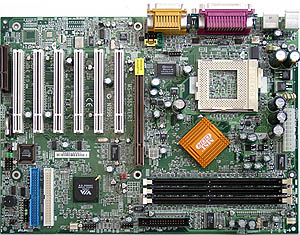
But too close position of DIMM slots to the chipset makes impossible to place IDE connectors in front of them because of an additional buffer chip. It takes a place in front of the slots forcing the IDE connectors out to the left. The battery is positioned upright, next to the CNR slot. The board is equipped with AC'97 sound, but it's impossible to reach them when a video adapter is installed. Besides, in case of a long video card you will hardly install memory. Stability of both boards is excellent due to high-quality voltage changers. The sockets are positioned very good so that you can easily install big coolers. But why the performance of these boards is so low? The Plus board falls behind just significantly, while the Master doesn't succeed at all. Maybe, the company was just lacking for human resources for the Pro266 chipset. But not so long ago we tested AMD760 based board from MSI which turned out to be one of the fastest. 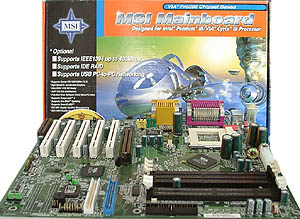 Now comes the Pro266 Master board. Its left upper corner follows the design of the Plus. But the support of two memory types explains some factors described below. First of all, the PCB is larger in size: the board has two SDRAM slots and three DDR. Secondly, usage of two different memory types provides for usage of terminators. MSI has unsoldered the terminators on the board thus making the size even more. 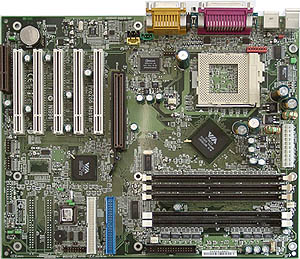 As a result, the board looks square. ATA100 RAID chip from Promise, 2 additional IDE connectors are located on the left. So is the battery which is positioned horizontally. But the RAID is not unsoldered... But why instead of an AGP Pro and 6 PCI, like on the Pro266 Plus, we have only an AGP and 5 PCI slots? However, now with a video adapter installed you can set DIMM's as many as you want, and an AGP slot has a clamp to fix cards strongly. The BIOS Setup of both boards allows changing a processor frequency in 1 MHz steps from 66 to 166 MHz, and core voltage from -0.1V to +0.15V (from the rated value) in 0.05V steps. Besides, there are wide possibilities for adjusting memory timings and SDRAM frequency - FSB, FSB+33 and FSB-33. EPoX 3VHA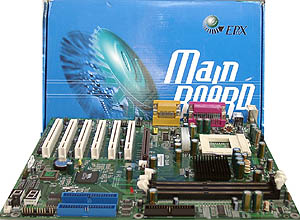 The board is supplied together with a CD with drivers, a detailed user's guide, ATA33 and ATA100 cables, FDD one and an additional bracket with 2 USB ports. The board has an AGP, 6 PCI and 1 CNR slot shared with the last PCI one. The AGP slot, like on all latest EPoX boards, has a clamp for cards. 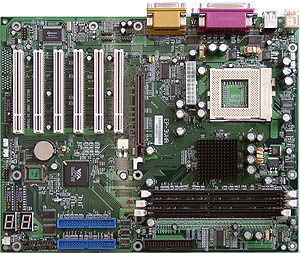 The board measures 30.5 by 24.5 cm. All the components are positioned quite competently. IDE connectors are situated on the left, athwart to PCI slots and rather far from each other. The FDD connector is positioned ideally, right in front of DDR slots. You may face problems when connecting an audio cable (the board is equipped with AC'97 sound from VIA), when replacing memory modules and when installing a long AGP card. The voltage changers are made with 2200uF capacitors. The power supply connector is located in parallel to an AGP slot. On the one hand, it may make problems for users who have power supply units with short cables; on the other hand, it excludes any additional pickups. As a result, the board is very stable. The socket's position is very good. It is turned to the edge of the board with the side where coolers are to be clamped. The capacitors are located far enough from the socket so that you can install any cooler. The BIOS is based on the 6.00PG version from AWARD and has standard features for the boards based on this chipset. You can adjust memory timings and distribute manually IRQ among slots. Besides, you can change the SDRAM frequency: FSB, FSB+33 and FSB-33. All overclocking features are available from the BIOS. You can set the FSB frequency from 66 to 166 MHz in 1 MHz steps. The core voltage can be changed from -0.1V to +0.25V (from the rated value) in 0.05V steps. The I/O voltage can be also changed up to +0.7V from the rated value in 0.1V. Chaintech 6VJD2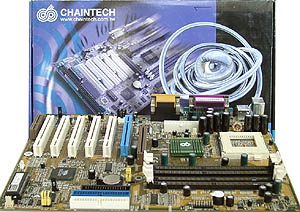 The Chaintech 6VJD2, like the MSI Pro266 Master, supports two memory types. Since DDR memory costs today almost the same as SDRAM, such boards are not very popular. Today there are not many buyers of the board which support two memory types because of a high price and a large size. 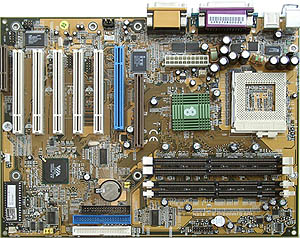 The 6VJD2 has a more compact size than the MSI Pro266 Master at the expense of 4 DIMMs - 2 DDR and 2 SDRAM. 4 out of 5 boards in our review have an FDD connector in the most optimal place: in the middle of the board, in front of DIMMs. But in case of the Chaintech 6VJD2 it's located closer to the IDE connectors which stick together so closely that it's very difficult to connect cables. The 6VJD2 is more similar to the 6VJD than to the MSI Pro266 Master or Pro266 Plus. Both boards have an identical combination of slots with two being intended for communication devices - ACR (Advanced Communication Riser) and CNR (Communication Network Riser) to the detriment of one PCI. Why there are two slots with almost identical functions is unclear. The board has standard drawbacks: a power supply connector is tucked in between a processor and an AGP slot. Besides, memory modules may be difficult to install when a video card is inserted into an AGP slot. The BIOS is based on the v6.00PG from AWARD. In memory settings you can change latency and bank interleaving (we used this possibility for all boards since interleaving of 4 banks provides for the best performance). The SDRAM frequency can be set either as FSB, or FSB+33 or FSB-33. A processor speed can be changed from 66 to 170 MHz in 1 MHz steps. The core voltage can be raised up to 0.3V in 0.05V steps. But VIO and Vmem are fixed. Soltek 65DRVAn auto overclocking program included in the BIOS called Red Storm has become a distinguishing feature of the company. At the same time a well thought-out design, high-quality voltage changers and a possibility to change voltage of all components manually allow the storm to rage in all its beauty. Soltek doesn't strive for developing out boards on all chipsets. But at the same time you can be sure that the boards it produces are high-efficient and very stable. In particular, it concerns the Pro266 based 65DRV board. The packages of Soltek are in the latest fashion: they are now relief with bright metallic colors. 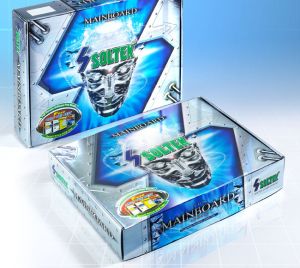 Exactly such new box contains an additional heat-sensor; a folding box with two CDs with drivers and additional software; two user's guides for the board and for the second disc with drivers, and ATA100 and FDD cables. Among the programs I'd like to mark out FAR STONE Virtual Drive - the best virtual CD-ROM drive, which delivers from a necessity to use CDs if you have a large HDD; you have to rewrite a CD image on the hard disc only once with the help of the Virtual Drive. The today's software from Soltek is the most useful: apart from Virtual Drive there are TREND MICRO PC-cillin 2000, PowerQuest Drive Image and PowerQuest PartitionMagic. 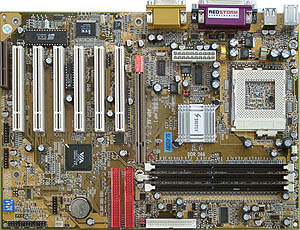 The Soltek 65DRV board is rather small as a DDR solution: it measures only 30.5 by 22cm. But such a compact design doesn't worsen the convenience. The drawbacks are standard: a power supply connector is located next to the joystick's port; memory modules are impossible to replace if a video adapter is installed. But the board has some vivid advantages: there is an AGP Pro connector with a possibility to change the AGP voltage by 0.1 and by 0.2V, 6 PCI slots, 1 CNR. FDD and IDE connectors are positioned very good. A high-quality unit of voltage changers and a power supply connector being located close to it ensure high stability of the board. Since the capacitors are rather far from the Socket-370 you can install any cooler you like. The Soltek 65DRV outscores all other competitors in stability and performance. Besides, its overclocking possibilities correspond to the high level: the Red Storm technology will help you to choose an optimal frequency of the processor; apart from the changeable AGP voltage you may add the voltage to the memory modules with jumpers - it may be 2.6 or 2.7V. The DIP-switch will help you set the FSB frequency: 66, 100 and 133 MHz. All other possibilities are available in the BIOS which is based on the v6.00PG from AWARD. The processor frequency can be lifted from 66 to 183 MHz. Its voltage can be also changed. Besides, you may change latency, bank interleaving and SDRAM frequency - FSB, FSB+33 and FSB-33. PerformanceTest equipment:
Software:
The test stands have changed a bit as compared with the first part, but as a reference board we used the Gigabyte 6RX - a leader of the first part.  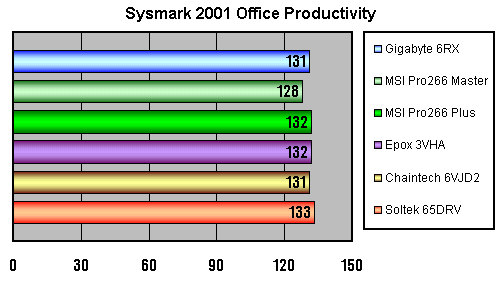   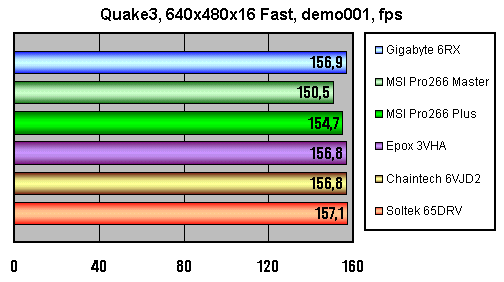 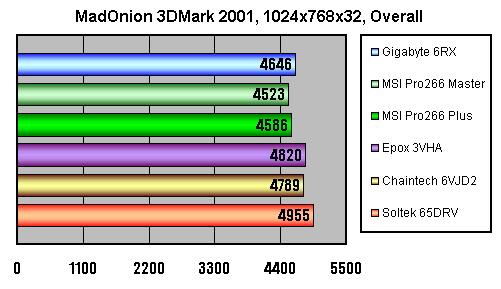 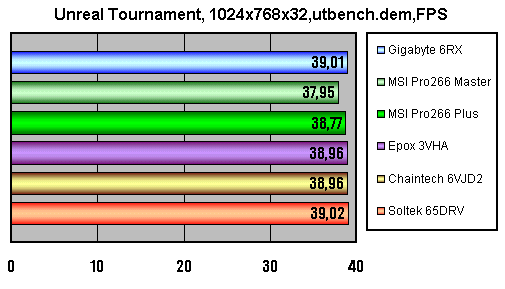 The comments are needless - an unquestioning victory of the Soltek 65DRV and poor results of the MSI boards. ConclusionMSI Pro266 Plus and MSI Pro266 Master - it's difficult to make an objective conclusion because of sad performance results, that is why we leave it for you to decide. EPoX 3VHA - a decent motherboard. Chaintech 6VJD2 - a high-quality motherboard but without any super possibilities for adjusting its settings. Soltek 65DRV - the highest performance and stability.
It's the best system (as far as efficiency in concerned) based on
the Pentium III, taking into account that Pentium III processors
are still available for sale and DDR memory costs almost as the
SDRAM.
Write a comment below. No registration needed!
|
Platform · Video · Multimedia · Mobile · Other || About us & Privacy policy · Twitter · Facebook Copyright © Byrds Research & Publishing, Ltd., 1997–2011. All rights reserved. | |||||||||||||||||||||||||||||||||||||||||||||||||||||||||||||||||||||||||||||||||||||||||||||||||||||||||||||||||||||||||||||||||||||